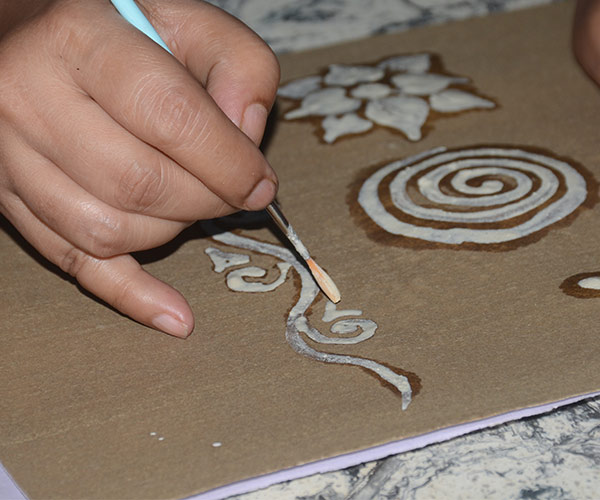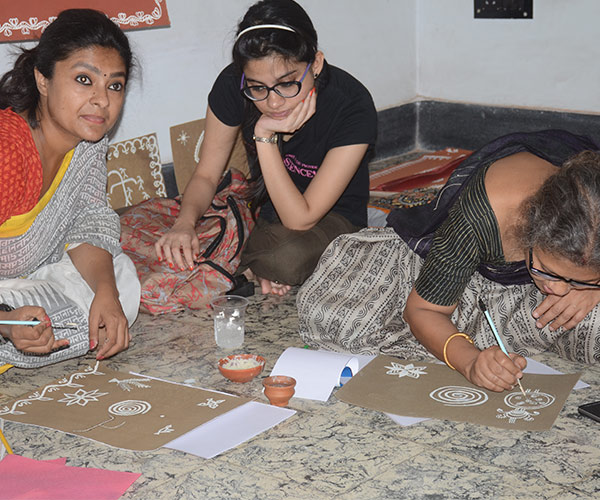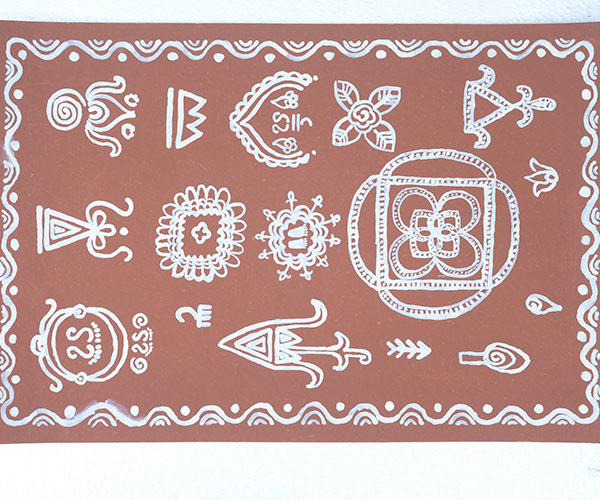Workshops & Exhibitions
Tal Patar Sepai – Workshop on Traditional Palm Leaf Sepoy Making. Date: 28th September 2019, Mentor: Shri Madan Mohan Dutta of Guskara, Burdwan, West Bengal. Invited Artists: Shri Hiran Mitra, Prof. Partha Pratim Deb, Shri Bipin Bihari Martha, Shri Saumen Khamrui
Even a cursory mention of Taalpatar Sepai or palm leaf soldiers invokes an intense sense of nostalgia and Romanticism in all of us. It’s something that’s essentially rustic, existentially socio-cultural, and brilliantly sarcastic. In both its content and form, this art form is intrinsically Bangali in heart. With a history worth centuries in the making, this incolves making cleverly jointed soldier-figuries from the leaves of the palmyra tree. Once a staple of all village and suburban fairs, today this art form is facing the threat of oblivion. Thus, to infuse new life, Chalchitra Academy organised a workshop at the Nandimukh Cultural Centre on September 28, 2019 under the mentorship of Madan Mohan Dutta. Such artists as Hiran Mitra, Partha Pratim Deb, Bipin Bihari Martha, Soumen Kharui, etc. took part alongside many other amateurs participants, all of whom explored the history, techniques, and intricacies of this wonderful duality of art and craft. With an interactive session by Debdutta Gupta and a musical performance by Arpan Chakraborty, the day was marked with both a sense of yearning for our forgotten childhood and a new-found passion for our traditions.
Goyna-Bori – Workshop on Traditional Decorative Lentil Cake Making. Sponsored by Bhojohori Manna. Date: 27th January 2019. Mentors: Smt. Nilina Ghosh and Smt. Sucheta Mandal of Midnapore, West Bengal
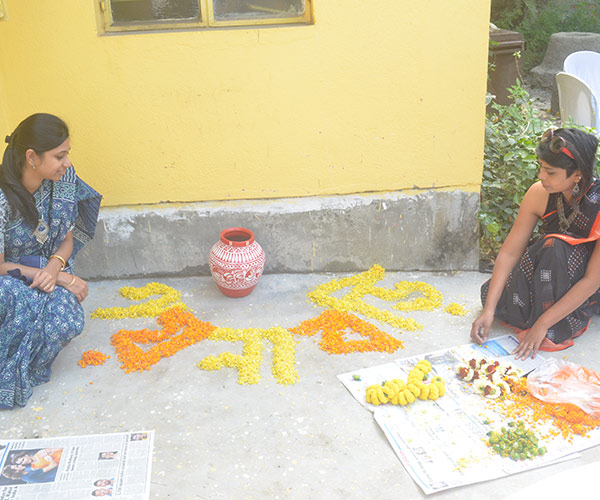
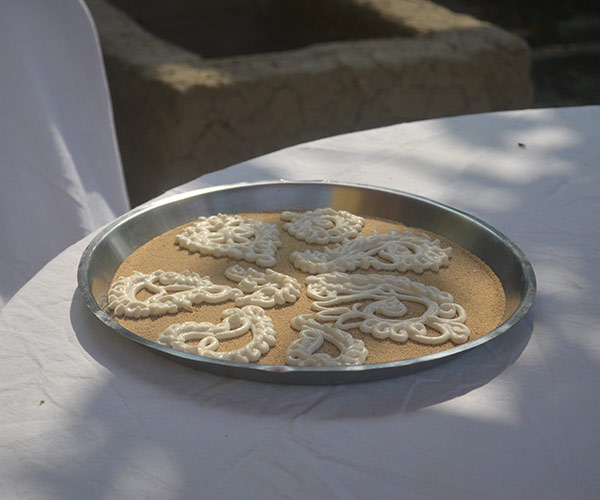
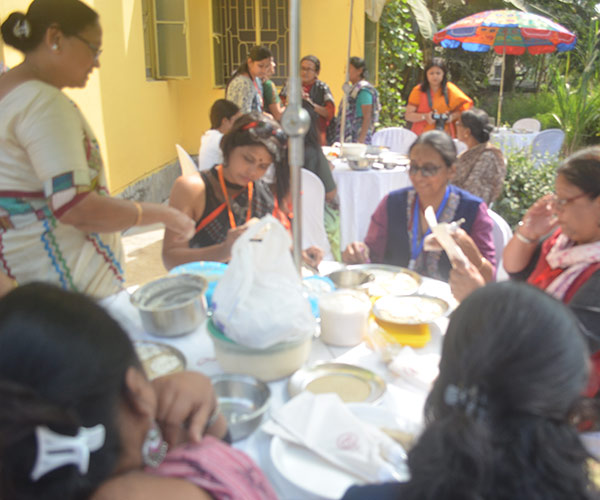
Dokrar Daak – Workshop on Dokra (Traditional Lost Wax) Metal Casting. Date: 25th November 2018. Mentors: Mukul Karmakar and Subho Karmakar of Dariyapur village, Burdwan, West Bengal. Invited Artists: Shri Jogen Chowdhury, Shri Tapas Konar, Shri Brindaban Chandra, Shri Prasenjit Sengupta, Shri Partha Dasgupta, Shri Tapas Biswas, Shri Satish Chandra, Shri Sambhu Nath Das
Dokra as an art-form has a history of centuries in Bengal since it migrated along with the artists from the region of Gondwana in the late middle-ages. Worked with bronze and bell-metal, it’s kernel lies in the epochs of the Indus Valley Civilisation with the art of lost-wax casting. Chalchitra Academy’s workshop “Dokrar Daak”, held on 25 November, 2018 at the Nandimukh Cultural Centre, Kolkata, had the art-historian Prof. Soujit Das as its observer and the eminent artist Jogen Chowdhury as its chief guest. Coming from traditional and contemporary spheres of art, such stalwarts as Subha Karmakar, Mukul Karmakar, Tapas Konar, Prasenjit Sengupta, Mrinal Mandal, etc. crafted innumerable dokra figuries while experimenting with its form in a multiple number of ways that enriched the tradition while breaking new grounds. An enrapted group of participants furthered this experiment by infusing their untrained yet vivid spontaneity into the age-old art-form.
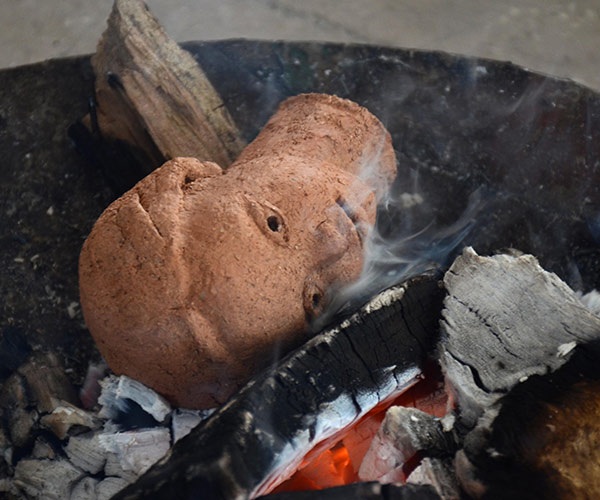
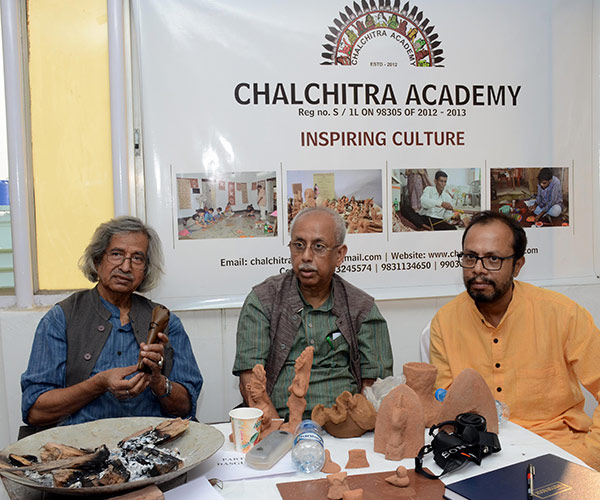
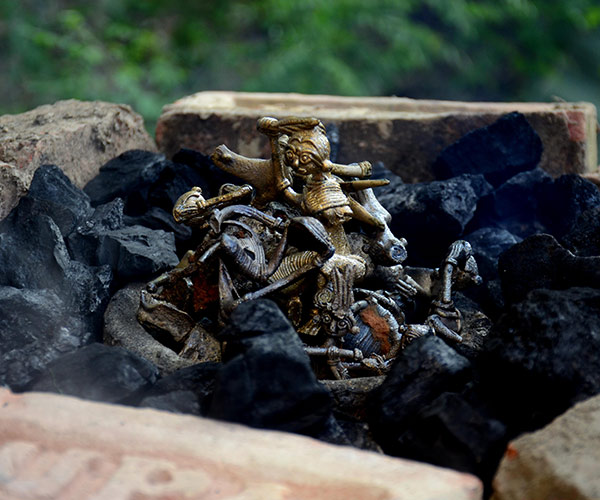
Babu Culture: Workshop on Traditional Babu Doll Making. Date: 26th August 2018. Mentors: Shri Sambhu Nath Das & Shri Goutam Das from North 24 Parganas, West Bengal. Invited Artists: Shri Pradip Rakshit, Shri Chayan Roy, Shri Samir Dutta, Shri Soumen Khamrui
Babu-putul is a curious art-form where the urban energy and the rustic ethos meet. Started by Kalicharan Das over 250 years ago when he migrated form Jessore to the Majilpur region of the then-undivided 24 Parganans, babu-putul entails a wide range of subjects. These snippets of life act as a counterpoint to the erstwhile Babu-culture of colonial Calcutta. Figurines of Barra-thakur and Banabibi from the deltaic lokayata culture, figures of sahebs, memsahebs, drunken babus, parvati-ganesha, burqa-clad women, all crowd up in the cornucopia of this little known tradition. On August 26, 2018, Chalchitra Academy organised its workshop at the Nandimukh Cultural Centre, Kolkata, where such eminent traditional and contemporary artists as Shambhunath Das, Gautam Das, Pradeep Rakshit, Soumen Khamarui, Mrinal Mandal, etc. worked their magic and gave a new life to this fast-eroding art-form. And, as is the long tradition of Chalchitra Academy, untrained amateur artists infused their raw energy to this dynamic mixture of forms, textures, and expression.
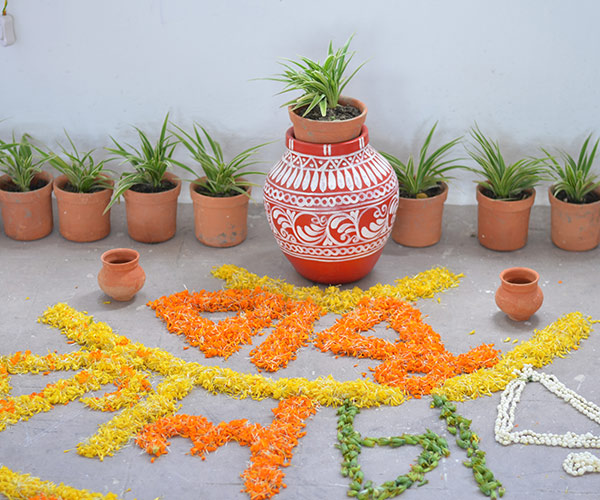
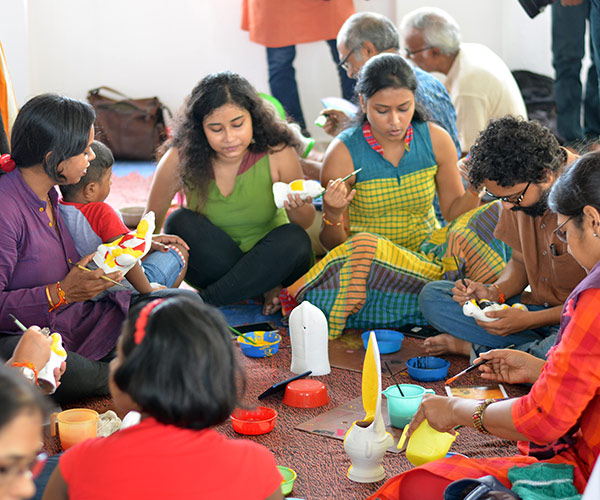
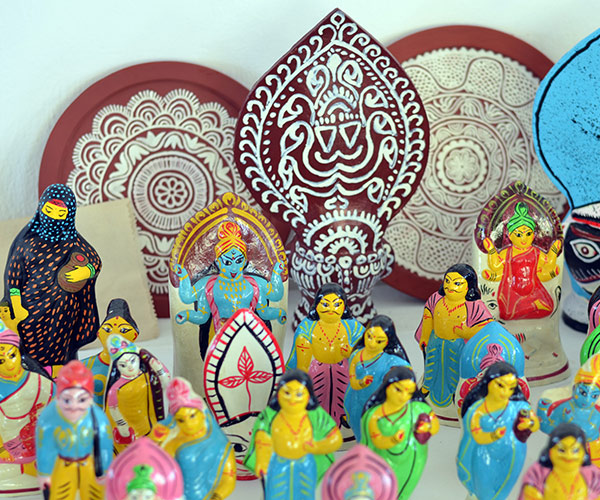
Alimpon-II : Alpana (Ritualistic Floor Painting) Making Workshop. Date: 10th February 2018, Mentor: Shri Bidhan Biswas
Long before the uncivilized Indo-Aryans arrived in India, the civilised Austro-Asiatic & Dravidian women of Bengal had a plethora of rich, intricate, and evocative rituals. They would decorate their houses in the villages and towns by drawing pictures of flowers, paddy fields, cows, peacocks, sun, moon, and such animistic items on the floor and walls while worshipping various spirits in a sort of elaborate communicative ceremony that connected between animistic, animalistic, shamanistic, and totemic nature-centric ideals. According to most experts, this was accompanied by rhythmic chanting of verses that asked for blessings for the entire household. These ceremony were extremely personal ones, each form representing an unfulfilled desire on the part of the worshipper. Gradually with the Indo-Aryan intrusion, society started to have a patriarchal and patrilinear shift and men became more dominant and priests started interfering in this world of ritualistic decorations & essentially matriarchal ceremonies. But in the eastern regions of India, especially in Bengal, this Indo-Aryan intrusion could never take root in depth like it did over large parts of northern India. Hence, the new class of male-priests, instead of stamping out the earlier threads of socio-cultural heritage created their own interpretations of the old art form on pieces of parchment or paper layered with a mixture of cow dung and mud. Then they used chalks of different colours to paint on them. In recent times, this folk culture has become nearly extinct. Presently merely a handful artists survive who are experts at this ancient art form. Chalchitra Academy, through the workshop Alimpan commemorated this Alpana art form on the 5th of April, 2015, at Selimpur. This workshop was mentored by Sri Bidhan Biswas, a famous traditional Alpana artist and avid collector from Krishnanagar, Nadia.
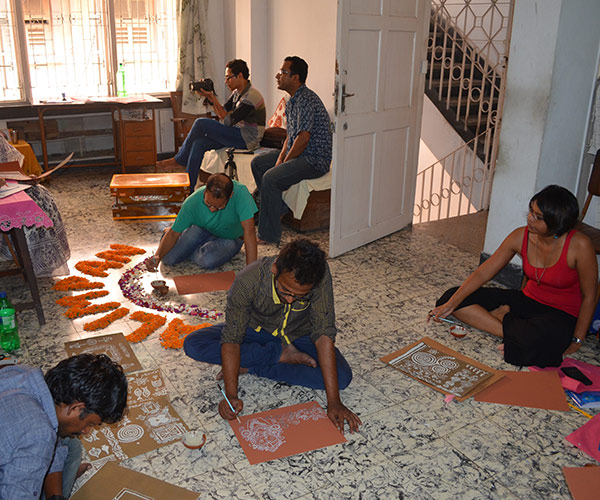
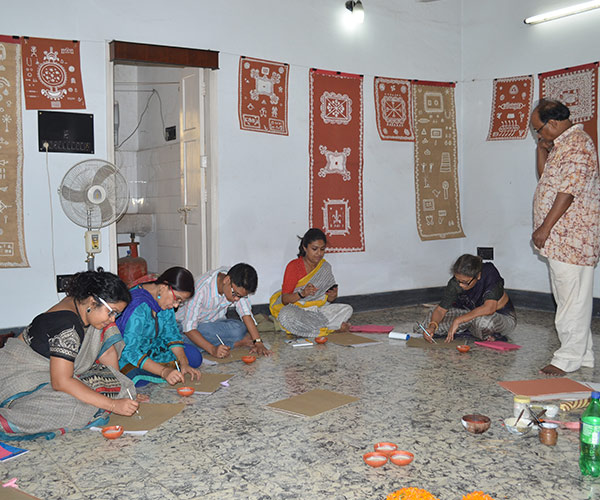
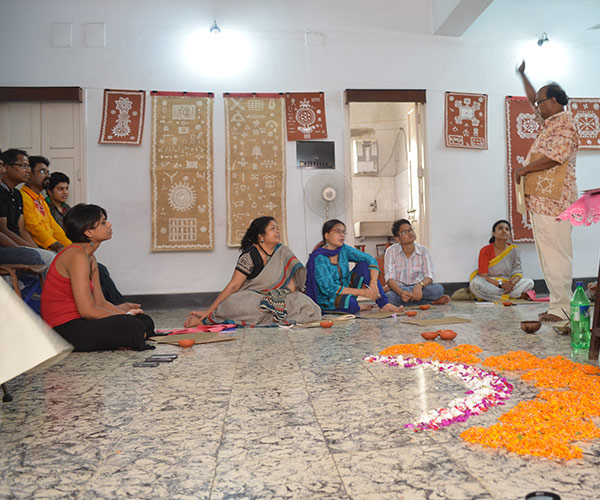
Mukhoser Mukh – Chhau Mask Making Workshop. Date: 4th June 2017. Mentors: Shri Bholanath Sutradhar and Shri Taraknath Sutradhar of Chorida Village, Purulia, West Bengal. Invited Artists: Shri Sushanta Kumar Maharana, Shri Pradip Rakshit, Shri Koustav Dey
Chhau dance, is a semi classical Indian dance with martial, tribal and folk traditions, with origins in the proto-history of pre-Aryan eastern India. It is generally subdivided into three subtypes, the Purulia Chhau of West Bengal, the Seraikella Chhau of Jharkhand, and the Mayurbhanj Chhau of Odisha. The dance ranges from celebrating martial arts, acrobatics and athletics performed in festive themes of a folk dance, to a structured dance with religious themes found in Shaivism, Shaktism and Vaishnavism. The costumes vary between the styles, with Purulia and Serakeilla using masks to identify the character. The stories enacted by Chhau dancers include those from the Hindu epics the ‘Ramayana’ and the ‘Mahabharata’, the Puranas and other ancient & medieval Indian literature. Moreover in certain visual and performative aspects one can also find echoes of ancient animism and syncretic Buddhism. The dance is performed traditionally by troupes comprising solely men, regionally celebrated particularly during spring every year, and can be taken as a syncretic dance form that emerged from a fusion of classical Hindu dances and the traditions of ancient regional tribes. The dance brings together people from diverse socio-economic backgrounds in a festive and religious spirit. The knowledge of dance, music and mask-making is transmitted orally from one generation to the next. The two styles of Chhau dance that use masks (Purulia & Seraikella), blend within it forms of both dance and martial practices employing mock combat techniques (called khel), stylized gaits of birds and animals (called chalis and topkas) and movements based on the chores of village housewives (called uflis). Dating back to some 150 years, the tradition of making Chhau masks started during the rule of king Madan Mohan Singh Deo of Baghmundi. The masks used in the Chhau dance of Purulia are mainly for portraying mythological characters such as Mahishasur-Mardini, Rama-Sita, the fight of Rama and Rabana, etc. Sometimes small Santhal couple-masks are also used, thus furthering the idea of syncresis. The masks have feathers and other ornaments that surround the face, which can be extended 2 feet from the mask itself. Different colours are used to portray the various gods, goddesses, heroes, and demons. Made by artists from the Sutradhar community (from the ancient regions of Manbhum & Shikharbhum) the masks go through various stages. 8–10 layers of soft paper immersed in diluted resin-based glue are pasted layer by layer on the mould before the mud mould is dusted with fine ash-powder. The facial features are made from clay. A special layer of mud and cloth is applied and the masks are then sun-dried. After this, the mould is polished and a second round of sun drying is done before separating the layers of cloth and paper from the mould. After finishing and drilling of holes for the nose and eyes, the masks are coloured and decorated with organic materials created from plants and minerals. Under the mentorship of two traditional Chhau-mask-making artists, Bholanath Sutradhar & Taraknath Sutradhar, Chalchitra Academy organized the event “Chhau Mask-making workshop” at the Ganges Art Gallery, Kolkata, on June 4, 2017. Along with a large number of enthusiastic participants, some of the contemporary artists who took part in a creative & intellectual dialogue and practice with this age-old art-form were Mrinal Mandal, Sushanta Kumar Maharana, Pradip Rakshit, and Koustav Dey. The day reached its vivid fulfillment with an interactive session by the Curator & Secretary of the Gurusaday Museum, Shri Bijan Kumar Mondal.
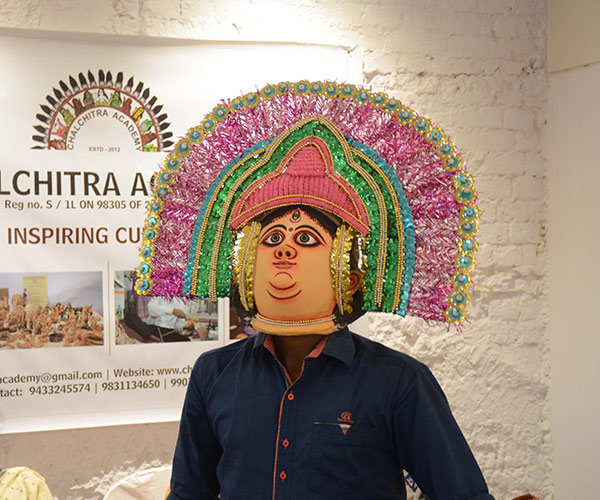
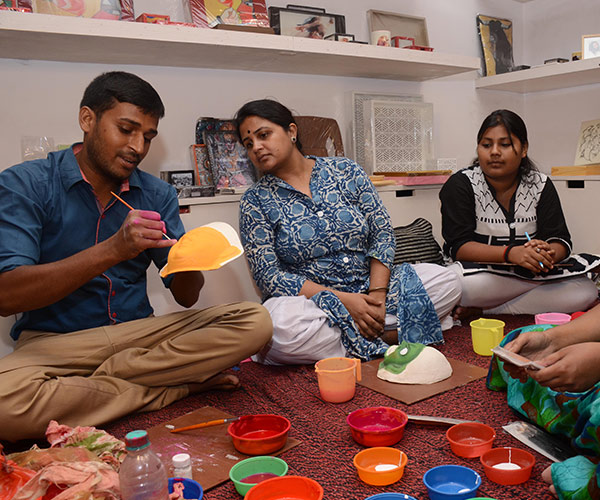
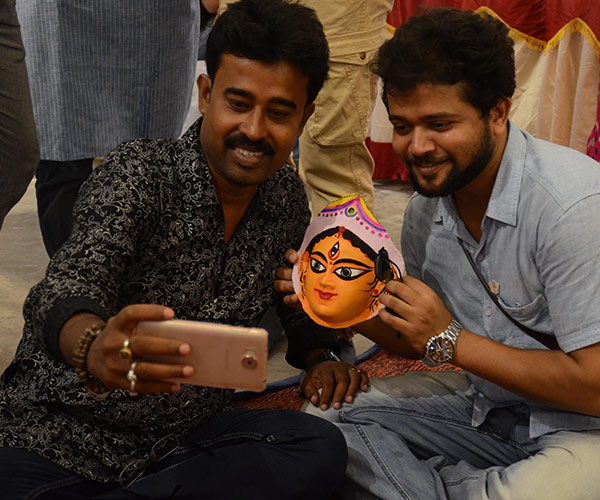
Shola Kala – Workshop on Sholapith Art. Date: 21st August 2016. Mentors: Smt. Krishna Bhaskar and Shri Arun Bhaskar. Invited Artists: Shri Samir Dutta, Shri Chayan Roy, Shri Soumen Khamrui, Shri Uday Deb, Shri Sayak Mitra
Sholapith or Indian cork is a spongey aquatic plant that grows all along the countless large and small waterbodies all over Bengal. Sprouting in the summer it grows along with the monsoon and is harvested in the shape of fine sheets with “Kaait”, a razor-sharp sickle-like knife. From thence the journey of sholapith is no less than a diorama that encapsulates the complete trajectory of Bengal’s socio-cultural being. Hardly is there any ritual or festival that sees not its use in some form or the other. The milky-white sheets of shola is used to decorate the puja-mandaps, deckup all brides and grooms, and as votive objects in funeral rituals. One can find various centres of folk-art and arisanship that use sholapith in myridas of manners, e.g. flowers and garlands in Maheshpur, South 24 Pgs, Choudal for Tusu festival and Chandmaalaa in Bankura, marriage artifacts like Topor in Howrah and Hughly, patashilpa in Contai and Keshiari, Medinipur, daaker saaj in Bonkapasi, Krishnagar, everyday items in Murshidabad and Birbhum, masks in Malda and Dinajpur, Bishahara-Saaitol patashilpa and Maasaan patashilpa in Kochbihar and Jalpaiguri, etc. Other than this major centres of sholapith, almost all parganas all-over Bengal sees artisanal & artistic usage of shola. On the 21st of August, 2016, Chalchitra Academy organised the workshop “Shola Kala” at the Ganges Art Gallery, Kolkata. Mentored by Krishna Bhaskar and Arun Bhaskar, two tenured traditional sholapith-artists from the Nadia district and initiated by an interactive session by the eminent lokaja artists Bidhan Biswas, the workshop saw traditions and modernity blend together in ways hitherto unseen. The fact that the two mentors were eminent stalwarts in ivory-art before it got banned made this artistic experiment even more interesting along with the valuable inputs put forth by such city-based artists as Samir Dutta, Chayan Roy, Soumen Khamarui, Uday Deb, Sayak Mitra, etc. and countless other artists and enthusiasts.
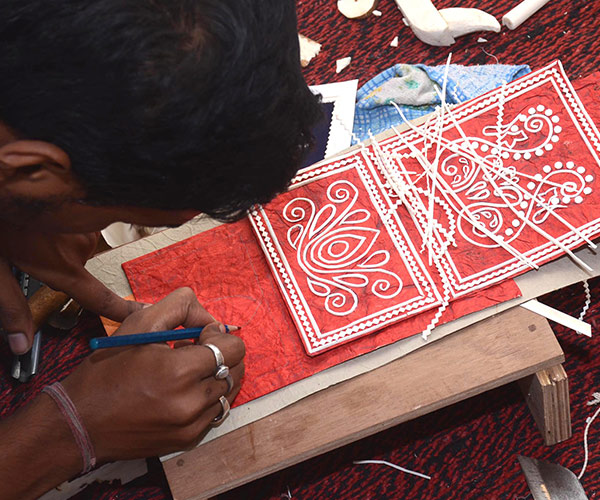
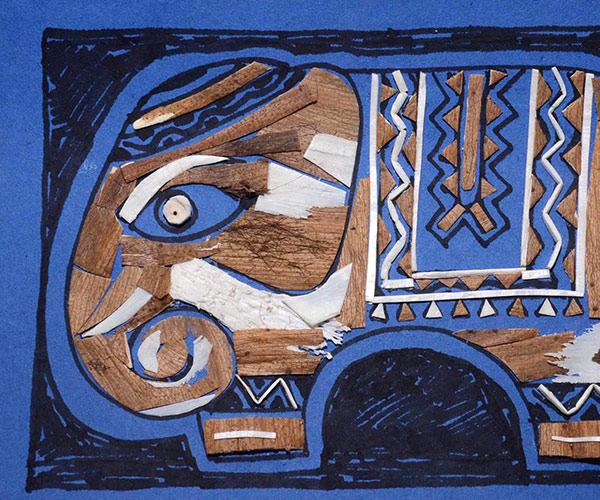
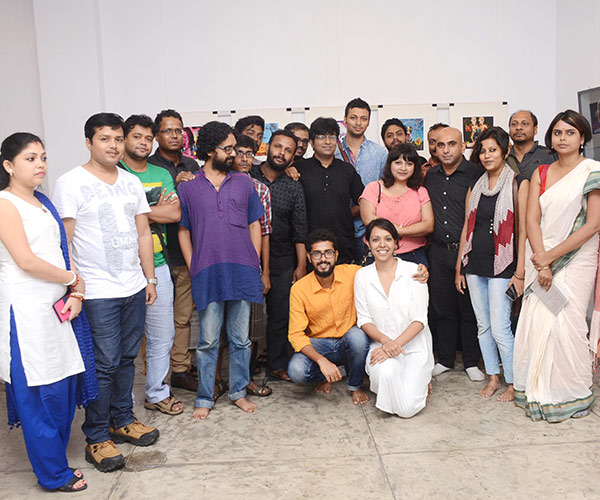
Transformation II – An Exhibition of Tribal, Folk and Contemporary Art in Collaboration with Ganges Art Gallery. Date: 19th – 21st August 2016.
The spirit of Transformation carried on to its second part as a multi-dimensional exhibition of tribal, folk, and contemporary art that was held from the 19th to 21st of August, 2016, at the Ganges Art Gallery, Kolkata. Inaugurated by the eminent art-house film director Pradipta Bhattacharya, the event was graced by Smita Bajoria, the Danish Consul General. Headlined by “The Dreamcatcher”, a video art show prepared by the US-based artist Sayak Mitra, some of the artists and collectives whose works fulfilled the exhibition were Arun Bhaskar, Bhanu Pan, Bidhan Biswas, Brindaban Chanda, Buddhadeb Karmakar, Chayan Roy, Debanan Sasmal, H. Akup Buchemhu, Jagneswar Hansda, Krishna Bhaskar, Krishnendu Chaki, Koustabh Chakraborty, Mrinal Mandal, Manu Chitrakar, Mrinmoyee Deb, Print on Print, Rameswar Saren, Samir Dutta, Satish Chandra, Saumen Khamarui, Saurav Dhabal Deb, Shreya Goswami, Subir Biswas, Sumanta Chakraborty, Sunil Kumar Pal, Sushanta Kumar Maharana, Sukanto Pal, Tracy Lee Stum, Uday Deb, and Uday Shankar Mondal. Furthermore the ambience was livened up by the music of Koustav Dey and the script-and-recitation presentation by Anushree Tapadar
Transformation I - An Exhibition of Indigenous and Contemporary Art in Collaboration with Creative Instinct. Date: 18th June 2016. Venue: Kailash Apartment, Mumbai.
On the 18th of June, 2016, Chalchitra Academy organized a unique exhibition at the office of National Award-winning production and art designers Subrata Chakraborty and Amit Roy, situated in Goregaon (West) Mumbai’s Filmistan Studio. Organised by the artist Mrinal Mandal and designer Jayati Bhattacharya and inaugurated by the eminent singer Rekha Bharadwaj, the event was made even more prestigious by the presence of the writer, columnist, and documentary filmmaker Rinki Roy Bhattacharya, daughter of the legendary Bimal Roy. The exhibition entailed patachitra from the Kalighat-school, Adivasi art, dokra works, terracotta, shola-art, wooden masks, and loads of graphic print created by the talented artists of Kolkata’s Lalitkala Academy.
Pot-Akopot – Worshop on Patachitra (Scroll Painting) of Bengal, Date: 27th December 2015. Mentor: Shri Manu Chitrakar and his daughters Ms. Mau and Ms.Ria from Nayagram village, West Midnapore, West Bengal
Patachitra is an art form that is passionately pre-Aryan in its glorious heritage. Through its form, content, tradition, and narration it captures the diorama of thousands of years across varied (yet intimately interlinked) cultures, languages, religiosity, and artistic gharanas. The sage Patanjali in his famous text “Mahabhashya”, which dates to the 2nd century BCE, mentioned the pat painters. Reference to Pat painting can also be found in the Buddhist Jataka stories and the Jain text “Kalpasutra”. The great poet and playwright Kalidasa also wrote about these painters in his famous kavyas “Avigyanam Sakuntalam” and “Malabika Agnimitram”. Bengal has had a rich history of Pat painters. Be it the Jodu Patuas of Mallabhum, Manbhum, Birbhum, Dhalbhum, Mediniour, Utkala or Kalighat, pata-painting captures the syncretic ideals of the timeless lokayata being. Folklores, mainstream religions, contemporary socio-political stories, etc. everything finds their own unique niches herein. The paintings of these Pat painters illustrate the vibrancy of existence, brought to life through vivid colours and an unique story-telling technique that hinges between kavya and bhashya. T hey paint on paper with colours made from natural sources. There are either canvases in series or a single canvas normally relating to some cycle of mythologies and folktales. An example of the latter would be the “Mora Haja Pot” wherein they paint and tell the whereabouts of the people who would have been lost while hunting in the dense forests of the Junglemahal. The artists display their painting by singing a chant-like song to illustrate their work. In recent times some contemporary topics have been portrayed as subject matter of the patachitras, such as the destruction of the Twin Towers in the USA, effect of pollution on environment and its remedies, and many others. The modern day artists also paint on different mediums like t-shirts, sarees, etc. Once this art form was the tool for Buddhist bhikkhus, pandits, and wayfarers to describe the space-time continuum of the cosmos within and without, the nature of shunyata, and the transience & inter-dependantness of all phenomenon through the act of unfurling a pata-scroll. Yet today this art form is facing the dire pangs of abject poverty and a neglect thrust upon by a westernised urban culture. Pot-Akopot was a workshop on the heritage of Patachitra of Bengal that took place on the 27th December, 2015, at Selimpur. T he mentor for this workshop was the renowned Patachitra artist Manu Chitrakar from Nayagram, West Midnapore. H is daughters Mau and Ria also accompanied him. A lecture was delivered by Prof. Sujit Kumar Mandal from the Department of Comparative Literature, Jadavpur University, in which he clearly illustrated the stages of development of Patachitra in Bengal vis-à-vis the deplorable socio-economic conditions of the modern patuas. The world renowned 3D illusion artist Ms. Tracy Lee Stum of California, USA was a participant in this workshop. With her unique style, she uses the world as her canvas. She mesmerised the entire crowd of guests, artists, and participants by her wonderful creation in which she painted on a 2D canvas a painting which created the illusion of a water-tank containing fishes which seemed to be jumping out of the tank. She involved everybody around her intimately in the matrix of the whole painting. Many contemporary artists also participated in this workshop. The folk music band Folk-Us from Konnagar, Hughly, lightened up the proceedings with a soulful rendering of folk songs.
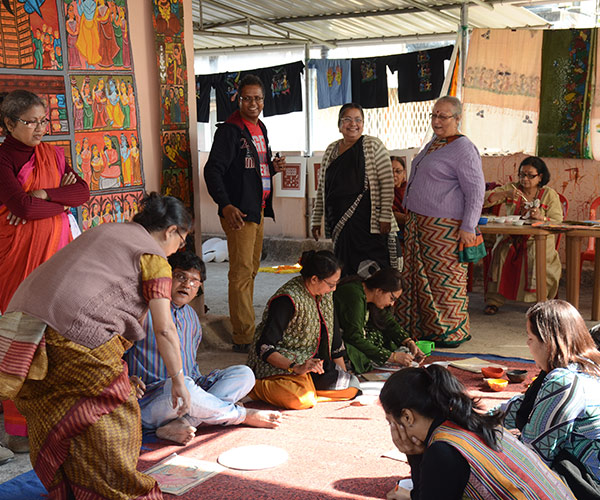
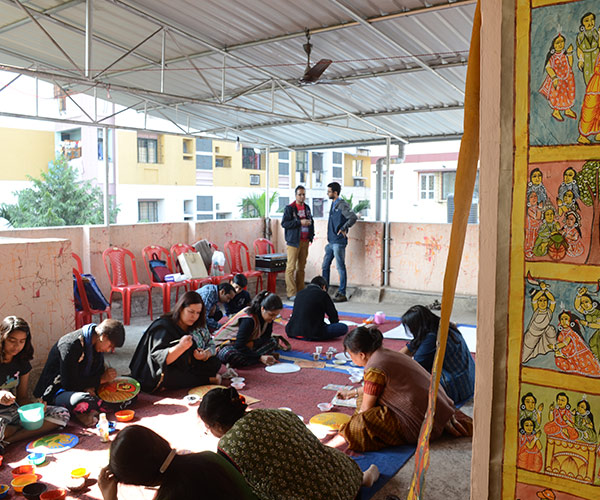
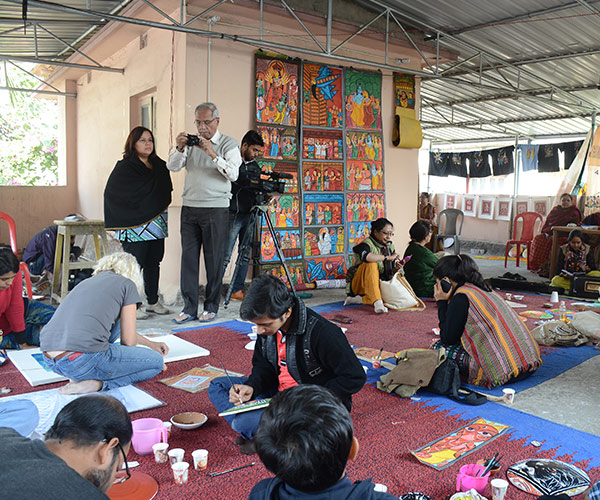
Laksha-Deep – Workshop on Shellac Art. Date: 13th & 14th June 2015. Mentor: Shri Brindaban Chanda from PaschimShai village, East Midnapore, West Bengal. Invited Artist: Prof. Manoj Sarkar and Shri Sourav Jana
At around 1500 CE, the shellac art form entered Bengal from western regions of India with the encouragement of the Mughal general Raja Man Singh. The artisans of Bengal started by covering terracotta bangles with shellac. Later, the art form shifted to covering-up terracotta dolls with a layer of shellac. Shellac terracotta dolls, in their general shape, are similar to the ‘Mother God’ sculpture found in the Harappan and other chalcolithic ruins. The next stage was shellac painting on terracotta figurines in the form of animal figurines which were often used as votive objects. The mud from termite nests is used for terracotta statues. The clay models are then dried in shade and fired in a furnace. Shellac sticks are made from adding organic colours to raw shellac. These are then used to decorate the burnt clay models in bright vibrant colours. Laksha-Deep, a workshop organised by Chalchitra Acadey took place on 13th and 14th of June, 2015. The guide for this event was the senior shellac artist and master craftsman – Sri Brindaban Chanda from the village of Paschim Shai , district of East Midnapore. Asst. Prof. Saurav Jana of the Burdwan College of Art & Design further engaged the participants by sharing a slide show on the gradual evolution of dolls in India vis-a-vis various socio-cultural stages. An interactive session followed this lecture where the special guest, Prof. Manoj Sarkar, Reg. Sec. Of Kolkata’s Lalit Kala Akademi, along with various artists and amateurs took part.
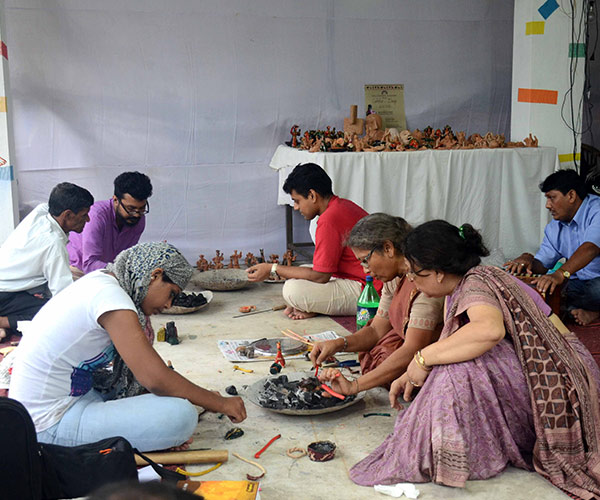
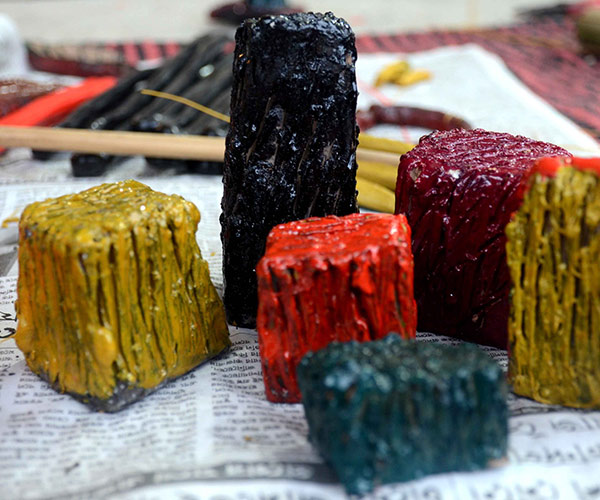
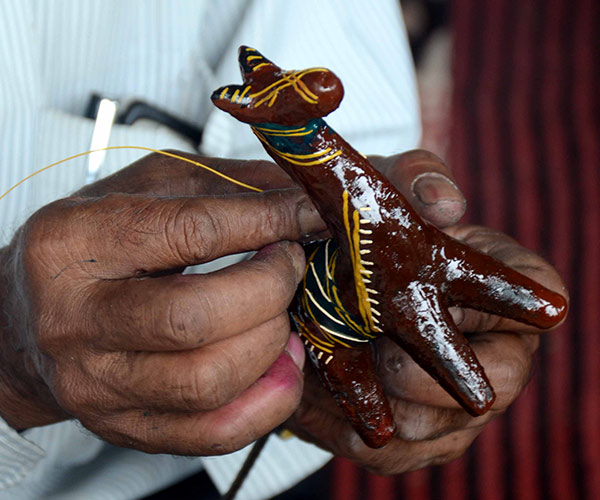
Alimpon – Alpana (Ritualistic Floor Painting) Making Workshop. Date: 5th April 2015. Mentor: Shri Bidhan Biswas
Long before the uncivilized Indo-Aryans arrived in India, the civilised Austro-Asiatic & Dravidian women of Bengal had a plethora of rich, intricate, and evocative rituals. They would decorate their houses in the villages and towns by drawing pictures of flowers, paddy fields, cows, peacocks, sun, moon, and such animistic items on the floor and walls while worshipping various spirits in a sort of elaborate communicative ceremony that connected between animistic, animalistic, shamanistic, and totemic nature-centric ideals. According to most experts, this was accompanied by rhythmic chanting of verses that asked for blessings for the entire household. These ceremony were extremely personal ones, each form representing an unfulfilled desire on the part of the worshipper. Gradually with the Indo-Aryan intrusion, society started to have a patriarchal and patrilinear shift and men became more dominant and priests started interfering in this world of ritualistic decorations & essentially matriarchal ceremonies. But in the eastern regions of India, especially in Bengal, this Indo-Aryan intrusion could never take root in depth like it did over large parts of northern India. Hence, the new class of male-priests, instead of stamping out the earlier threads of socio-cultural heritage created their own interpretations of the old art form on pieces of parchment or paper layered with a mixture of cow dung and mud. Then they used chalks of different colours to paint on them. In recent times, this folk culture has become nearly extinct. Presently merely a handful artists survive who are experts at this ancient art form. Chalchitra Academy, through the workshop Alimpan commemorated this Alpana art form on the 5th of April, 2015, at Selimpur. This workshop was mentored by Sri Bidhan Biswas, a famous traditional Alpana artist and avid collector from Krishnanagar, Nadia. Sri Animesh Baidya, a researcher from Jadavpur University, also conducted an interactive session on this topic. The participants of the workshop were further enriched by the musical recital of Sri Rishi Chakraborty and Sri Raghu Roy Choudhury based on the typical folk theme of Nabanna (the festival of crop harvesting) and Bratokatha (the ritualistic chanting that accompany the alpanas).
